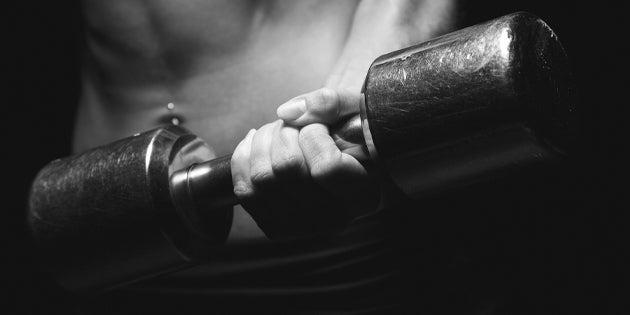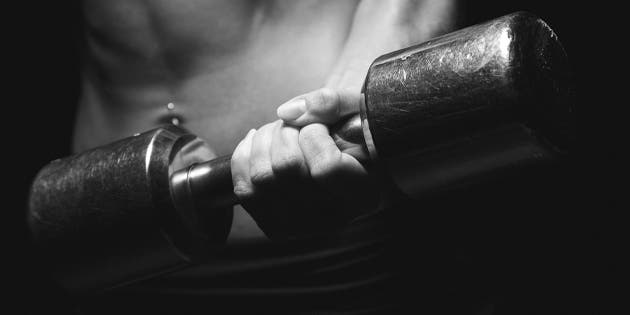Intensity Techniques For Building Muscle & Strength


You know of them, but you probably haven’t thought about them in a while. At least, that’s the feeling you get when reading over the roster of D-list competitors for Donald Trump’s television hit (or train wreck, depending on your druthers) The Celebrity Apprentice. Surely, you’d have to Google most of the names among the 16 hopefuls to discover that Jamie Anderson is a snowboarder, Brandi Glanville is a “real housewife” (you have to wonder what an “unreal” housewife would look like), and Ian Ziering was perpetual high-school frat-boy Steve on 90210.
Well, like the Donald, we also have some dusty old favorites in our fitness attic, but remembering them will do more than just pique your pop-culture curiosity. Indeed, these three “forgotten” training techniques — ascending/descending sets, rest/pause and partial reps — will help push you farther than you might otherwise go on your own during a workout. Each technique works in the same way — by prompting a growth-hormone surge in response to the extended effort against a challenging resistance and a recovery response by forcing additional blood into your muscles (i.e., the “pump” you feel).
“These techniques provide a great amount of volume, give you variety in your program and are very time-efficient,” says David Hooper, graduate research assistant at The Ohio State University. “Moderate loads of 60 to 80 percent of your one-rep maximum and a short rest period create a substantial volume, which is a great stimulus for hypertrophy.” Incorporate these techniques into your own training, and say these infamous words to your exercise routines of the past: “You’re fired!”
Technique 1: Ascending/Descending sets
aka “Running the Rack” or “Running the Stack”
The premise of this method is simple: You’re either moving up (ascending) or down (descending) in weight during one super-long set. Extending your sets like this increases the time under tension for your muscles, which in turn forces adaptation and change.
You can increase or decrease the weight as many times as you’d like during your set, depending on your masochistic leanings for the day. Let’s use the machine chest press as an example of a moderately intense ascending set, changing weight four times. Begin by setting the weight stack with 5-pound weights per side for 10 reps. After rep 10, immediately change the pin setting on the weight stack so that you’re next using 10 pounds per side and go for another 10 reps. Again without resting, move the pin again setting the weight at 15 pounds per side and do still another 10 reps (or as many as you can muster). Finally, move the pin up to the 20-pound weights and rep until you can’t go anymore. For a descending set (also called a “drop set”), reverse that sequence, starting with your heaviest weight and decreasing every time you reach a point of initial failure.
An ascending set on its own serves as a good warm-up for any bodypart, while a descending set is a super finisher. The good news is you should only have to do one ascending or descending set per exercise and per workout to reach kaputville.
Word of caution: Be aware that certain exercise techniques may upset your fellow gym-goers. Running the rack using a series of dumbbells, for example, may not be practical during the gym’s peak hours because this technique can have you monopolizing a lot of gym real estate, which may not sit well with other gym members. Rule of thumb for ascending/descending sets: If your ascending/descending set will require a lot of real estate, you might want to choose another technique or train during non-peak hours when the gym isn’t so packed with members.
Try It Yourself
Pick an exercise in your next workout to try either an ascending or a descending set, such as machine chest presses or machine shoulder lateral raises or cable curls.
“This technique is traditionally done with dumbbells, but you could easily do it with a machine that you can easily adjust,” says Cari Shoemate, a personal trainer and yoga instructor based in Houston (cari-fit.com). For example, use a cable machine with a rope attachment for doing triceps pressdowns: Start either with a low weight and build with each set or with a heavy weight and drop with each set.
If you want to get creative, try using a bodyweight exercise. Shoemate explains: “Try descending sets with push-ups. Using a bench and step, work your way from the hardest angle to the easiest, starting with high-decline push-ups (feet on a bench), then to low-decline push-ups (feet on a step), then regular push-ups and finally incline push-ups with your hands on a step, feet on the floor.”
Technique 2: Rest/Pause
This awkwardly named technique is simple: You stop and rest midset, which allows your body’s short-term energy systems — specifically the phosphagen system, which produces energy without the need for oxygen — to naturally recharge itself. Even just 15 seconds gives your body enough time to regain a significant amount of strength, allowing you to extend the set by at least a few repetitions.
“This technique is great for those wanting to build strength and muscle quickly,” says Felicia Romero, IFBB Figure pro, personal trainer and motivational speaker based in Gilbert, Arizona. The technique compresses more work into a shorter period, thus increasing your overall intensity, and higher levels of training intensity have been shown to increase muscle adaptation.
To save time and keep a modicum of tension on the muscle, don’t put the weights down but simply rest in the start position — for instance, the down position on a seated shoulder press or biceps curl. (You may discover it’s better to rest at the fully flexed position for exercises such as the leg press, in which it’s easier to hold the weight with legs extended.)
Try It Yourself
Pick a challenging exercise for one or two bodyparts, and use rest/pause on the last set of that exercise each week. For example, perform the seated lat pulldown. Get into the standard position and do as many perfect reps as you can. Once you reach a point at which you can’t quite do another rep with excellent form, stop and “rest” with your arms outstretched for 15 to 20 seconds, concentrating on deep, relaxing breaths. Then continue repping, getting in as many more as you can before terminating the set.
Another exercise to try is pull-ups. Set a goal — say, 25 total reps — then try to hit that mark, taking as many 15- to 20-second rests as needed. In between, either completely let go of the bar and stand on the floor or rest in the hanging position, your choice.
Technique 3: Partial Reps
In Oxygen, we love to preach about doing full range-of-motion reps. And in fact, studies confirm that stopping short robs you of the complete benefit of an exercise. That said, there is a time when a less-than-complete rep is not only acceptable but encouraged.
Partial reps allow you to extend a set beyond the point of initial failure, putting more beneficial stress on your muscles and promoting a hormone response that sets recovery and repair activity into motion. You may not be able to do a full rep anymore, but you can likely still move through part of it, trying for three-quarters, then a half and then one-quarter reps, stopping when even those become impossible.
“I’ve always been a fan of partial reps because they can be done anywhere and with any type of weights or resistance,” Shoemate says. Partial reps typically focus more on building muscle endurance versus strength, but it really depends on how you do them. “If you’re doing higher reps, then your focus will be more on endurance,” Shoemate says. “But if you only do a certain angle or range of motion and are using heavier weights, it’ll definitely build strength and give muscles more shape and definition.”
Because they’re so intense, use partial reps sparingly on a set or two at the end of a workout once or twice a month. Try it with dumbbell hammer biceps curls:
“Start with full reps, doing as many as you can,” Shoemate says. “When you can no longer get the weight all the way to the top, start doing half reps. When that becomes impossible, finish with quarter-range-of-motion to ‘pulse’ reps, stopping when the burn is red hot and you can’t move the weight anymore using just your biceps.”
In addition, Romero suggests a quarter squat to build your legs. “Set the safety bars in a squat rack so you can only lower yourself one-quarter of the way down before touching,” she explains. “Load the bar with 100 to 120 percent of your full squat one-rep max. [Editor’s Note: If you don’t know that figure, you can add 25 to 30 percent more weight to what you regularly lift for 10 reps.] Do the quarter squat, lowering until the bar touches the pins — then drive right back up through your heels to standing.” You can either do these quarter squats on their own or after regular squats in your leg workout.